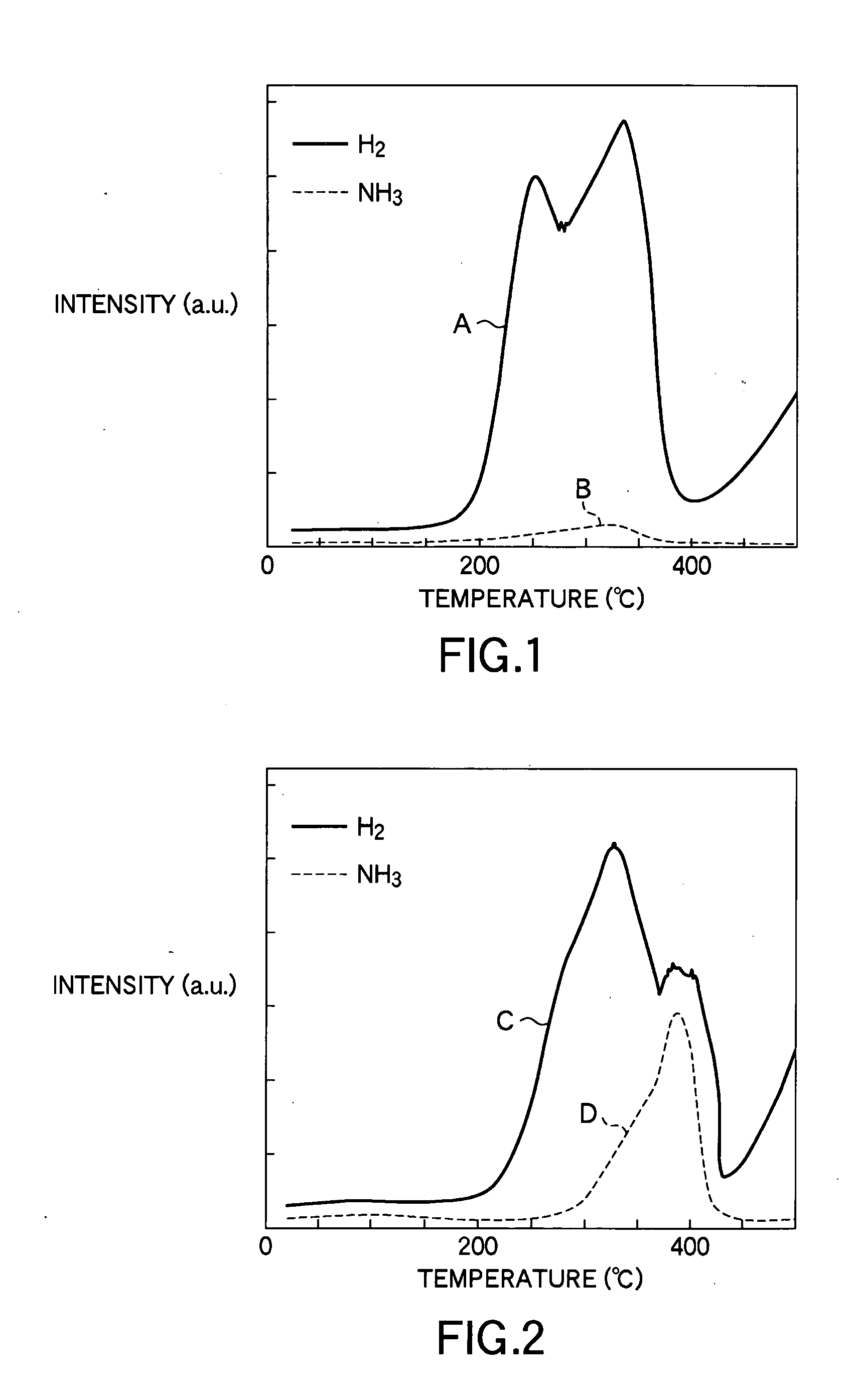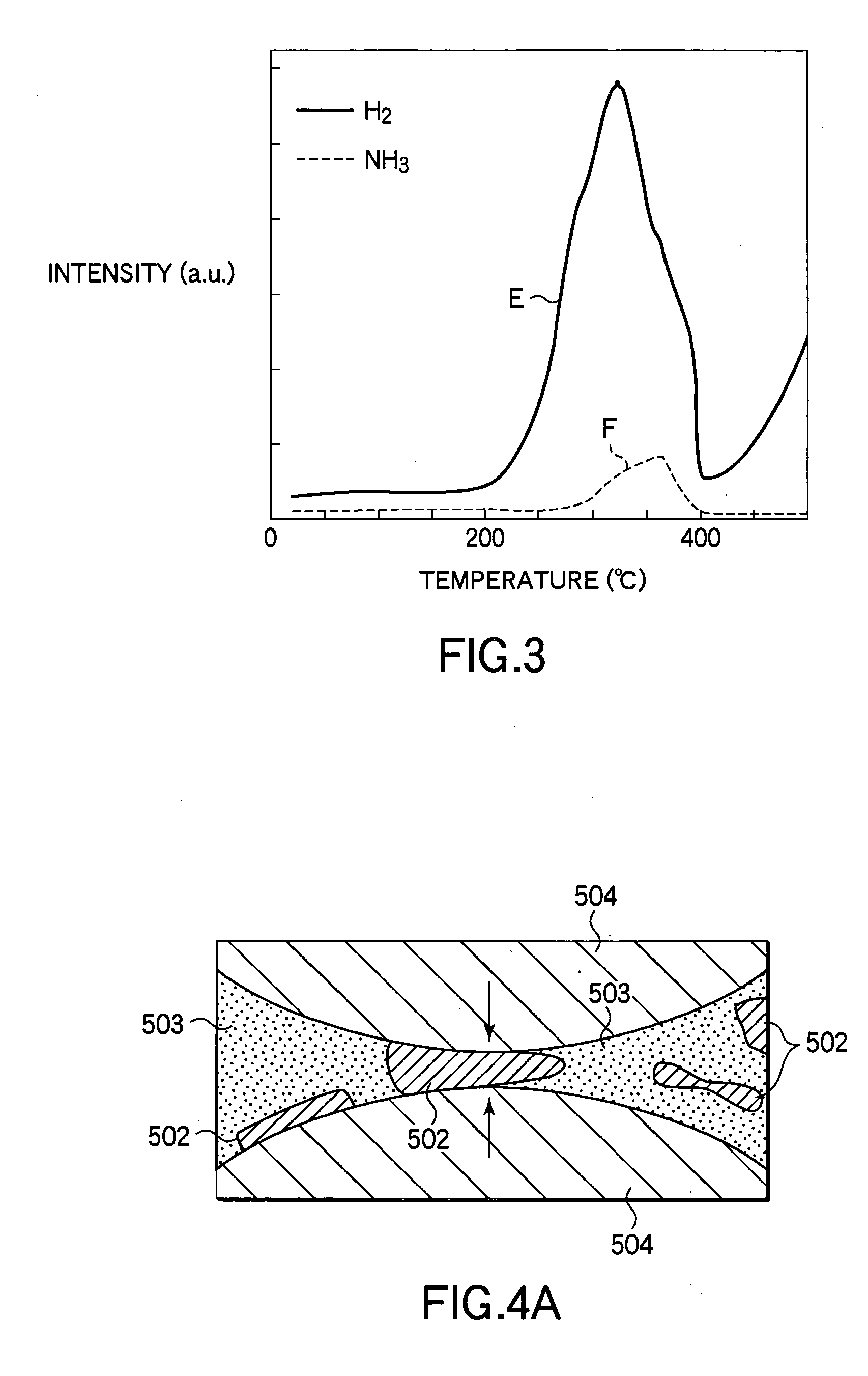Hydrogen storage matter and manufacturing method and apparatus for the same
a technology of hydrogen storage and manufacturing methods, applied in the direction of electrochemical generators, physical/chemical process catalysts, other chemical processes, etc., can solve the problems of reducing the efficiency of hydrogen storage, etc., to achieve high hydrogen storage ability, high efficiency, and easy handling
- Summary
- Abstract
- Description
- Claims
- Application Information
AI Technical Summary
Benefits of technology
Problems solved by technology
Method used
Image
Examples
example 1
PRESENT EXAMPLE 1
[0110] Accordingly, in the present example 1, in order to make microscopic contact repeated between LiNH2 and LiH, LiNH2 fine powder and LiH fine powder were weighed at a ratio of 1:1 by molecule number ratio, and subjected to an MeM process for two hours. Each of the LiNH2 fine powder and LiH fine powder was a reagent having an average particle diameter of several-ten μm (20 to 40 μm).
[0111] Specifically, for the MeM process, a mixture powder sample of LiNH2 and LiH mixed at a ratio of 1:1, a small amount of catalyst (0.3 grams), and 20 steel balls (with a diameter of 7 mm) were introduced into a steel pot (with an inner volume of 30 cc), and the interior of the container was set to have an atmosphere of a reducing gas, such as hydrogen, or an inactive gas, such as argon (Ar). Then, the container was driven to cause on-axis rotation and revolution at a rotational speed of 400 rpm to knead up the sample, so as to obtain powder particles of several-micron size that ...
example 2
PRESENT EXAMPLE 2
[0116] Next, an explanation will be given of a manufacturing method for a hydrogen storage matter, to which metal particles are added as a catalyst. Use of an MeM process can also facilitate adding a catalyst for increasing the hydrogen absorption and release reaction rate. Ni particles were added, at 1 mole % relative to the number of moles of Li, to a mixture of LiNH2 and LiH mixed at a molar ratio of 1:1, and the mixture was subjected to the same MeM process as in the present example 1 to form a sample. At this time, each of the LiNH2 fine powder and LiH fine powder had an average particle diameter of several-ten μm. Further, the Ni particles were Ni nano-particles having an average particle diameter of 20 nm.
[0117] Using the sample thus obtained, desorption gas due to heating was analyzed in terms of the mass number, as in the comparative example 1 and so forth. FIG. 6 is a view showing gas emission spectrum lines as a result of mass number analysis performed o...
example 3
PRESENT EXAMPLE 3
[0119] Next, an explanation will be given of a manufacturing method for a hydrogen storage matter, to which metal compound particles are added as a catalyst. Also in this example, use of an MeM process can facilitate adding a catalyst for increasing the hydrogen absorption and release reaction rate. Titanium trichloride (TiCl3) particles (with an average particle diameter of 2 to 4 μm) were added, at 1 mole % relative to the number of moles of Li, to a mixture of LiNH2 and LiH mixed at a molecule number ratio of 1:1, and the mixture was subjected to the same MeM process as in the present example 1 to form a sample.
[0120] Using the sample thus obtained, desorption gas due to heating was analyzed in terms of the mass number, as in the comparative example 1 and so forth. FIG. 7 is a view showing gas emission spectrum lines as a result of mass number analysis performed on desorption gas due to heating of the sample according to the present example 3. In FIG. 7, a chara...
PUM
| Property | Measurement | Unit |
|---|---|---|
| specific surface area | aaaaa | aaaaa |
| specific surface area | aaaaa | aaaaa |
| specific surface area | aaaaa | aaaaa |
Abstract
Description
Claims
Application Information
 Login to View More
Login to View More - R&D
- Intellectual Property
- Life Sciences
- Materials
- Tech Scout
- Unparalleled Data Quality
- Higher Quality Content
- 60% Fewer Hallucinations
Browse by: Latest US Patents, China's latest patents, Technical Efficacy Thesaurus, Application Domain, Technology Topic, Popular Technical Reports.
© 2025 PatSnap. All rights reserved.Legal|Privacy policy|Modern Slavery Act Transparency Statement|Sitemap|About US| Contact US: help@patsnap.com



